Alumni Weekend 2009 Welcomes Thousands to Campus
Throngs of alumni, students, faculty, and friends enjoyed more than 70 events on GW’s Foggy Bottom and Mount Vernon campuses during a sun-filled Alumni Weekend in Washington, D.C. The weekend’s events opened on Thursday, Oct. 1, with a ceremony at Washington’s W Hotel honoring the recipients of the Distinguished and Recent Alumni Achievement Awards: Paul Antony, MD ’96, MPH ’96; Andrew Brown, BA ’06, MPA ’08; Vincent C. Gray, BA ’64; Elizabeth McCartney, MA ’06; and Christina M. Puchalski, MD ’94.
On Friday, Washington Post columnist and Pulitzer Prize winner Steven Pearlstein discussed the roots of the international financial crisis to a packed house at GW’s Elliott School of International Affairs. Later that evening alumni gathered for a kickoff celebration in University Yard and the first-ever athletics reunion.
In a Saturday morning discussion about the state of the University, GW President Steven Knapp said GW was on track to become “the most powerful and significant research university in one of the most significant regions in the world.”
In the interview with Dick Golden, special assistant for broadcast operations and university events, Dr. Knapp detailed his priorities for the University, which include growing GW’s research operation, expanding public service, maintaining and strengthening partnerships with the D.C. community, and promoting sustainability. He also addressed tuition, the economy, and the University’s new Web site.
Other events on Saturday included a Taste of GW and Family Carnival featuring food from restaurants owned and managed by alumni across the D.C. area. GW graduates also got a behind-the-scenes tour of the newly renovated Charles E. Smith Center and a preview of the upcoming men’s and women’s basketball seasons with coaches Karl Hobbs and Mike Bozeman.
An alumni film festival showcased three movies: Mr. Schneider Goes to Washington by Jonathan Neil Schneider, BBA ’84; The U.S. vs. John Lennon by David Leaf, BBA ’73; and Charlie on Parole by Kevin Mead, BA ’09, and Darren Miller, BA ’09, and starring TJ Miller, BA ’03.
The weekend wrapped up with a “Sunday Conversation” and brunch with ABC News’ Sam Donaldson, who drew on his 48 years of experience in Washington and his one-on-one interviews with every president since Lyndon B. Johnson.
“Every president I’ve seen comes to office wanting to do good,” Donaldson told the audience of about 125 in GW’s Jack Morton Auditorium. “To work hard and get to be president, you have to believe that you singularly have the answer; no one else does.”
To learn more about activities planned for Alumni Weekend 2010, visit
www.alumni.gwu.edu/aw.
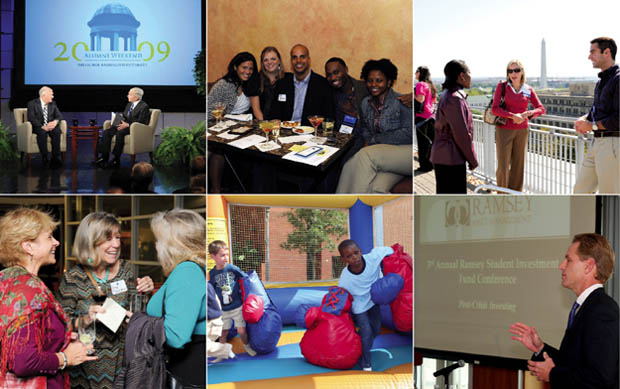
Clockwise from upper left: President Knapp discusses the state of the University with Dick Golden; alumni at a multicultural happy hour; GW grads enjoy the fall weather before a Luther Rice Society brunch; GW Board of Trustees Chairman W. Russell Ramsey, BBA ’81, speaks at the 3rd Annual Ramsey Student Investment Fund Conference; playtime at the Taste of GW and Family Carnival; alumnae reconnect at the 1970s reunion.
Photo credits: Dave Scavone, Andrew Snow, Julie Woodford
Building a Culture of Philanthropy
Investment in the next generation of leaders
Even in the midst of economic turmoil, alumni, parents, students, and friends of The George Washington University stepped forward with gifts to the power and promise of student aid. Contributions to student aid topped $12 million last year, up from $10 million the year before. In the Annual Fund alone, the dollar contributions increased by almost 50 percent, and the number of donors to student aid nearly doubled.
In a year that was difficult for many of our sister institutions, The George Washington University was able to exceed last year’s fundraising by 17 percent from the 2007-08 fiscal year, bringing in a total of $103.9 million from individuals, foundations, corporations, and a significant grant from an affiliate organization.
In an unforgettable year for the financial markets, the endowment did not escape unscathed. GW’s endowment assets decreased by $245 million to $1.011 billion, a loss of 21.4 percent—below the average among institutions that saw losses as high as 25 percent. Twenty-seven new endowment funds were created, and $25.1 million in gifts and transfers was contributed to the endowment.
The Charles E. Smith Center Exceeding Expectations
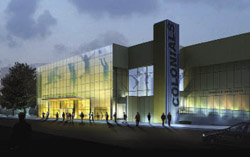 A rendering of the Charles E. Smith Center’s Phase III, which will be a complete rebuilding of the exterior facade
A rendering of the Charles E. Smith Center’s Phase III, which will be a complete rebuilding of the exterior facade
As the 2009-10 academic year began, GW students, faculty, staff, parents and friends saw the completion of Phase I and II of the transformation of the Charles E. Smith Center, the signature building that marks the heart of campus life. Without missing a beat or canceling an event for Phase I and II, the center welcomed 2,500 new students and parents during Freshman Convocation, and the refurbished “Tex” Silverman Court hosted the first GW volleyball women’s team, which defeated Rhode Island before the fifth-largest gathering to watch a GW volleyball match at the center.
About $25 million of the $43 million project will be funded by philanthropy. Much of the funding will come through a $10 million challenge gift from the Robert H. Smith and Charles E. Smith Family Foundations and Robert P. and Arlene R. Kogod—one of the largest philanthropic gifts in GW history. The challenge gift, which is a one-for-one match, is almost two-thirds complete.
The 5,000-seat arena that hosts an array of University, athletic, and entertainment events received a face-lift that makes attending events more comfortable for visitors and playing games more appealing for athletes. In the new arena, old bleacher-style seats were swapped for more comfortable, contoured, roomier seats. The completion of Phase II includes expanded facilities for the athletes. Each of the 14 men’s and women’s sports teams has its own locker room, and teams get better-configured spaces. Renovations also include two levels with an expanded fitness room; a varsity weight room; an academic center; a golf simulation room; an expanded sports medicine suite; and a fully equipped Colonial Club VIP booster room next to the arena. A newly refinished convertible racquetball/squash court has a sliding glass wall that can be easily adjusted to create either a regulation racquetball or squash court. Refurbished, more comfortable spaces to view arena activity await the members of the Athletic Director’s and Colonial Clubs.
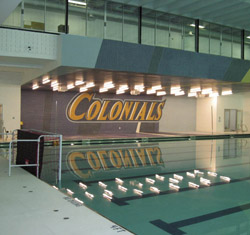 The refinished natatorium, which is now open for use
The refinished natatorium, which is now open for use
Renovations also incorporate school pride in a clean, streamlined look. In the refinished natatorium—which includes new starter blocks, tiles, and retractable benches with chair backs—a Colonials logo design and school colors blaze across the walls in tiny, laser-cut tiles.
The footprint of the Charles E. Smith Center didn’t grow, but among the improvements are the efficient engineering and maximizing of existing space—adding 6,000 new square feet for use. In keeping with the University’s goals in sustainability, the transformation will include many “green” features, such as energy-efficient lighting in the arena that is projected to save about $66,000 per year in electricity costs. Other eco-friendly features include an efficient HVAC system throughout the building and flooring made of recycled tires in the weight room and fitness center.
Phase III, the final renovation phase, will include a complete rebuilding of the exterior facade, which will be a striking glass side of the modern building. Interior projects include the concessions concourse, box office, and additional entrances with lobbies on the second and third floors to ease the flow of attendee traffic and allow visitors more comfort. This phase includes reworking of two auxiliary gyms used by nearly every sport, from cricket to field hockey.
“It is a complete transformation of the existing Charles E. Smith Center,” says Jason Wilson, assistant athletic director of facilities, events, and operations. “The center served us well for so many years—it was time to update and renovate the facility. In today’s day and age, you need a campus center for athletics, entertainment, and big University events. This transformation gives us that center.”
For information on supporting the Charles E. Smith Center transformation, please contact Dan Rocha at 202-994-9366 or drocha@gwu.edu.
Philanthropy as Partnership: Anonymous Donor Gives $2 Million
After visiting a campus filled with energetic GW students who want to change the world, and then learning about the transformation of the Charles E. Smith Center, a donor stepped forward with a $2 million gift toward the Charles E. Smith Center project.
“It gave me great pleasure to give,” says the donor, who wishes to remain anonymous. “In my view, philanthropy needs to make an impact and carry some leverage. When I heard and saw how important the Charles E. Smith Center transformation is to the University, and when I learned about the challenge grant from the Smith and Kogod families, I was keen to step up and set an example. Their challenge gift is an incredibly generous commitment that I wanted to honor.”
The donor, who supports several educational institutions, made a point of learning about GW and its aspirations. “When I decided to support The George Washington University, I spoke with administrators, trustees, and staff. Everyone articulated a clear set of priorities coherently and unselfishly. And everyone mentioned the Charles E. Smith Center.” Moreover, adds the donor, “GW is in a fantastic position to move forward. The University is very lucky to have dynamic, clear-thinking, hard-driving leadership in President Knapp and the board.”
After a tour of the completed Charles E. Smith Center’s Phase I and II (Phase III to be completed in early 2011) the donor noted that “It’s magnificent. The arena is brighter and more comfortable; the downstairs space is more functional and well thought-out and much more cheerful.” The donor added, “This is a world-class, central venue, not just for the University but for the surrounding community. It will be an excellent place for sports, entertainment events, and conferences. The transformation will re-establish the Charles E. Smith Center as it was when it was first built—a central facility to bring together the University and its communities.”
“I consider myself to be an activist philanthropist,” the donor notes. “That means I don’t want to just write the check and walk away. I think donors should care about and be involved in the gifts they give. Philanthropy is more than a gift—it’s a true partnership between the institution and the donor.”
From The GWAA President
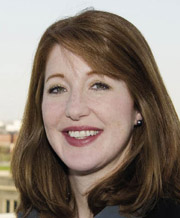
Dear Fellow Colonials,
If seeing my picture to the right of this column made you do a double take, don’t worry, I am sure you are not alone. Richard Crespin, BA ’93, who penned this column and steadily guided the GW Alumni Association for the past two years, completed his term as president this past summer.
I want to thank Richard, now the association’s immediate past president, for his leadership and dedication. Richard played a critical role in identifying and building the three pillars that serve as the foundation of your GW Alumni Association: Enabling Lifetime Engagement of Alumni, Gathering a Voice for Alumni, and Building a Culture of Philanthropy. While you may see a new face as GW Alumni Association president, let me reassure you that we will continue to concentrate on these three goals during my tenure.
Take, for example, Alumni Weekend 2009, which drew thousands of alumni, students, and friends to Washington, D.C., in early October. We “Enabled Lifetime Engagement” though more than 70 events. On Saturday we concurrently hosted the Taste of GW and Family Carnival and the 50th Reunion and Alumni Emeriti Society Luncheon. We “Gathered a Voice” by actively involving alumni in the planning process and through a state of the University conversation with President Steven Knapp. And alumni continued to “Build the Culture of Philanthropy” by volunteering to help plan their reunions and by giving back financially during the weekend.
We have done good work, but we cannot rest on our laurels. With that in mind, let me share with you several challenges I am going to focus my energy on in the coming year.
One of my areas of focus will be strategic planning; thinking about where we want to be 10 and 20 years down the road. We have formed a committee to tackle this daunting challenge, and we welcome your input.
A related issue is taking a closer look at the association’s revenue and expenses. We need to analyze what we are taking in, what we are spending, and where we can achieve greater efficiency. We do not want to eliminate good programs but need to think long term. For example, we gave out $30,000 in grants to alumni groups last year, and I want to make sure that is sustainable.
With respect to our benefits and services, we recognize that in this economic climate alumni career services and connections are more valuable than ever. We are providing valuable opportunities but need to continue to promote our offerings (learn more at alumni.gwu.edu/career).
Finally, we want to focus on expanding our ability to gather feedback and input from alumni. Some of you read the print version of this magazine and comment on it by writing a letter to the editor while others are more likely to read a story online and comment through a Tweet. We will continue to explore multiple platforms to engage with alumni and listen to your feedback.
With that in mind, I encourage you to share your thoughts and ideas. The Alumni Association exists to represent your interests. To do that well, we need to hear directly from you! Please contact me at gwaa@gwu.edu with your feedback, ideas, and suggestions.
Sincerely,
Laura Taddeucci Downs, BA ’92, MA ’95
President, GW Alumni Association, 2009-11
alumni.gwu.edu/gwaa
Alumni Honored with Achievement Awards
GW President Steven Knapp and The George Washington Alumni Association honored the 2009 recipients of the Distinguished and Recent Alumni Achievement Awards at a ceremony at Washington’s W Hotel on Oct. 1, 2009. The awardees are:
Paul Antony, MD ’96, MPH ’96, chief medical officer at the Pharmaceutical Research and Manufacturers of America and U.S. Navy reservist;
Andrew Brown, BA ’06, MPA ’08, founder and executive director of the Global Language Network, a not-for-profit organization helping communities improve business, political, and personal relationships through language and cultural education;
Vincent C. Gray, BA ’64, chairman of the Council of the District of Columbia;
Elizabeth McCartney, MA ’06, co-founder and director of the St. Bernard Project, a not-for-profit organization that creates housing opportunities so that Hurricane Katrina survivors can return to their homes and communities; and
Christina Puchalski, MD ’94, GME ’97, executive director and founder of the George Washington Institute for Spirituality and Health.
“This evening’s honorees have brought distinction to themselves, to their families, and to their communities through their professional and personal endeavors,” President Knapp said at the awards dinner. “Their accomplishments have profoundly affected the lives of those around them, and they have brought credit to the entire University community.”
Alumni Achievement Awards are presented to GW graduates who have made a lasting impact on society through outstanding professional, voluntary, or philanthropic accomplishments. The awards are the highest form of recognition given by the University and the GW Alumni Association to alumni on an annual basis.
Prior recipients of Alumni Achievement Awards include Julius Axelrod, PhD ’55, winner of the Nobel Prize in Medicine; Abby Joseph Cohen, MA ’76, Goldman Sachs senior investment strategist and president of Goldman’s Global Markets Institute; Colin Powell, MBA ’71, former U.S. secretary of state; and Kerry Washington, BA ’98, multi-award-winning actress and performing arts professional.
This is the 73rd annual presentation of the Distinguished Alumni Achievement Award. The George Washington Alumni Association implemented the Recent Alumni Achievement Award in 2007 to recognize graduates of the past 10 years.
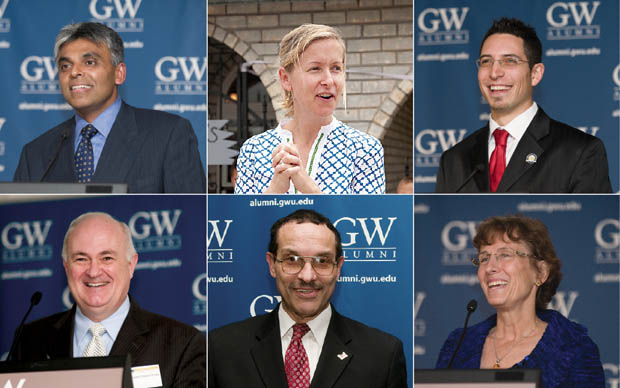
Clockwise from upper left: Paul Antony, Elizabeth McCartney, Andrew Brown, Christina Puchalski, Vincent Gray, and GW President Steven Knapp
Dave Scavone
GW Partners with Congressional Black Caucus Foundation
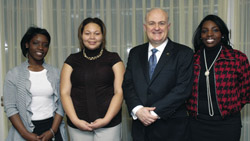 Ursula Lauriston, Starla Lloyd, President Steven Knapp, and Kayla Lucas
Ursula Lauriston, Starla Lloyd, President Steven Knapp, and Kayla Lucas
An exciting new partnership between the Congressional Black Caucus Foundation and Semester in Washington Politics program at The George Washington University allows students to merge practical experience on Capitol Hill with theoretical coursework in applied politics at GW. Students participating in the internship program earn academic credit from GW and are armed with valuable real-world political experience.
In the case of Ursula Lauriston, she earned a job, too.
Ms. Lauriston was a CBCF-GW Emerging Leaders Communications intern in the office of U.S. Sen. Roland Burris of Illinois in spring 2008. Two months into her internship, she was given the opportunity to address a CBCF-GW event in the Capitol attended by members of Congress, GW leadership, and congressional staff. The speech was received so well, it led to a job offer for a permanent position in Sen. Burris’s office, where Ms. Lauriston is now a press assistant preparing press statements, releases, and speeches, among other duties.
“The CBCF-GW internship,” Ms. Lauriston notes, “provided the opportunity to live in a new city and continue my education with great professors and guest lecturers, some of whom I had seen on television and who were an important part of the Washington and national political scene. The internship has brought me closer to my aspirations.”
“This is a perfect example of how partnerships between GW and key organizations in Washington can enhance our efforts to make a GW education more accessible for more students,” says University President Steven Knapp.
The Congressional Black Caucus Foundation Inc. was established in 1976 as a nonpartisan research and education institute that aims to improve socioeconomic circumstances of African-Americans and other underserved communities.
Ms. Lauriston credits her CBCF-GW internship with building her confidence, teaching her how to network, and learning from GW professors and prominent guest speakers in her political management classes about how Washington really works. In her words, the CBCF-GW internship “brings you to the table.”
Visit the GW Web site to learn more about the University’s Semester in Washington Politics program.






